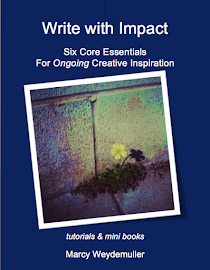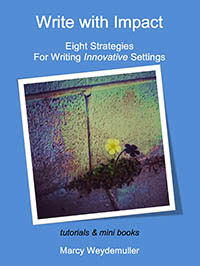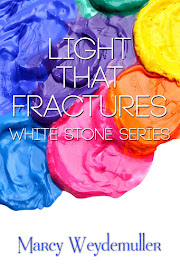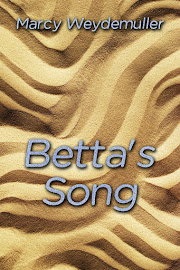Thursday, May 25, 2017
Overview Setting: Case Study: Invisible Light by Marcy Weydemuller
Workshop: An Introduction to Writing for Children and Young Adults
Some of the joys and heartaches of writing
are the surprises that turn up unexpectedly—especially after the first draft is
completed. We discover a thread we had not intended but does work well, or we
have written ourselves into a corner that doesn’t seem to have an answer.
So I thought I’d share with you a dilemma I
faced after my first few drafts of Invisible
Light that I hadn’t considered. And how setting helped me to solve it. And
it may have mattered to no one but me.
Ashia’s story set in contemporary San
Francisco. The poetry fairy tale story Ashia wrote is set in a loose version of
medieval times. Both stories seemed as far apart as possible and I wanted their
connection to be organic and not orchestrated.
As I read over I realized that the setting and tone in the
fairy tale were often connecting with Ashia’s confusion emotionally and when I
followed that thread I found a connection that helped me with the edit draft.
I don’t know
that it will make sense to anyone else but in this project setting helped me find
a bridge. I’ve posted one excerpt
below.
Share: What have you written recently
that surprised you?
Read deep, marcy
Excerpt Invisible Light Chapter Four
“He chose my childhood play tower for my dungeon
memories of sunlit days
hidden behind layered moss, an ivy-sewn
shroud.
Meeting of sky and water; river falling,
hurrying toward the sea.
Makeshift planks stretch across soggy banks
hesitant boards crackle under foot weight.
Masons quickly finish bricking parapet.
haunted faces refuse to look us in the eye,
melt into air as doorway closes.” …
…“Ashia sighed. She did know. It was the
complete dismissal of anything Ashia told her about the situation at school. Her
mom kept saying give it time—this city is different—or other ridiculous clichés.
Another thing the real Erinn Vaega would never include in her thoughts. The
reason she was so good in her field was the accuracy with which she could
discern insincerity, false motives, and hidden agendas.
Had
they both fallen under some kind of spell when they visited the office? Ashia
felt like she had with the fatigue that clung to her almost every moment at
school.”…
Thursday, May 18, 2017
Overview Setting: Genre Focus: Fantasy
Workshop: An Introduction to Writing for Children and Young Adults
“The created fantasy world must have its
own immutable laws.” Jane
Yolen
The key to fantasy
is belief.
Setting is integral to fantasy
and science fiction. Sometimes the setting is a ‘character’ itself. But even
when not used as a character it must become integral to the reality.
Jane Yolen notes that once you set up the
‘laws’ of the land: its premises and its logic—you cannot break it. Science Fiction leans on scientific laws or
inventions. Magic has consequences.
In Charlotte’s
Web, Charlotte could not be magically saved. There is only one ring that enables invisibility in The Lord of the Rings series, by J.R.R.
Tolkien. In Where the Wild Things Are,
by Maurice Sendak, only Max can choose to return away to his bedroom.
Reality is established through place,
character, and voice. Jane Yolen divides created worlds into three categories:
earthbound, faerie, and tourist
Earthbound is action in our world with
possibly fantastic characters such as found in Wind in The Willows, the
Borrowers, or Mary Poppins.
Faerie includes The Hobbit, The Riddle-Master
of Hed. They are in worlds totally apart both in time and space. They
include High Fantasy and usually include a serious tone of good and evil.
Tourist is a traveler who finds his way to
another time, or world, or dimension. Tom’s Midnight Garden, the land of Narnia,
Alice in Wonderland and Hogwart’s School are some examples of this category.
This category can be serious or humorous or both.
Just as an historical setting establishes
place, historical framework, season, time of day, moods, and atmosphere so
integral is the same to fantasy and science fiction. It must be authentic to
its premises.
And, like an historical, decisions need to be made re what are the
key factors that you want to maintain as its influence?
Action Steps:
If
fantasy or science fiction is your interest it is important to be well read.
1.
Choose whichever categories most interests you and set up a reading list of two
different series for two different age groups.
Or,
if you are not sure which draws you the most, choose two books from each
category to read over the next few months.
2.
Keep a personal reading log as you read, watching for gems of brilliance and
pieces that don’t work. Write down why you think it worked or why not.
Share: What is your favorite fantasy
novel? Why?
Read deep, marcy
Tuesday, May 16, 2017
Light That Fractures Thank you!
Thank you new readers for choosing Light That Fractures to read. Hope you enjoy.
Please take a few minutes to post a review, or a star rating, or both. Thanks!
Invisible Light-Book Two-Available
Meet Ashia, a teenager uprooted from her home and family battles against depression and hopelessness to find God’s light.
When seventeen-year-old Ashia abruptly moves to San Francisco five months before her graduation, she is propelled into isolation both at home, and school, where she is seen as an intruder. When she uncovers a web of deceit exposing a counterfeit principal manipulating the school system for personal gain, her emotional darkness begins to close around her. Ashia attempts to battle depression and hopelessness. She searches for the Lord’s light and finds refuge in her poetry.
Click on the cover and go straight to Amazon.
Read Deep, Marcy
Labels:
Faith,
Family,
Hope,
Invisible Light,
Light That Fractures,
White Stone Series
Saturday, May 13, 2017
White Stone Series Special Free Giveaway 4th Day. Last day tomorrow.
Light That Fractures
Meet Geena as she begins a new year faced with a choice. Pursue justice for her twin sister’s death regardless of consequences, or release her anger and allow healing to begin.
Still struggling with months of grief, Geena Morisi resolves to begin the New Year with hope instead of holding onto her anger. When an unexpected windfall arrives, she has to choose whether relinquishing her desire for justice betrays her twin sister’s memory or honors her life. Geena wavers back and forth between past and present trying to decide which path to take. Can she return to her art studies, manage her day care job, and raise her orphaned niece only on her own terms? Her decision will have repercussions to change not just her life, but Ana’s too.
Book One in the White Stones Series: Hope, Faith, Heart
Six young women face life transitions that create tense relationships and struggles of faith. Will they have the courage to challenge their personal fears and experience new beginnings that stretch their hearts into hope?
Click on the cover and go straight to Amazon. Hope you enjoy her story. If so, please take a few minutes to post a review, or a star rating, or both. Thanks!
Read Deep
Marcy
Labels:
Book One,
E-Book,
Faith,
Fiction,
Free Offer,
Hope,
Light That Fractures,
White Stone Series
Thursday, May 11, 2017
Overview Setting: Language: Tone
Workshop: An Introduction to Writing for Children and Young Adults
Tone overlaps with voice as we discussed
earlier. To be a background influence that impacts setting, the word choices
need to be precise giving a clear visual. Strong verbs that can stand on their
own without punctuation, such as exclamation marks, help give a solid
atmosphere.
Another way that tone can have an insightful
influence is when what one character is saying or acting outwardly while at the
same time is internally having an opposite or other emotional reaction. It
turns the setting upside down.
Take into consideration the age you’re
writing for as well. Five year-olds and under can rarely hide their feelings
from family members or even want to try. Unless? Perhaps they are in on a
surprise for a family member. And trying to keep a secret. There are
opportunities for all kinds of humorous misunderstandings all around.
The older the character, and the more intense
a situation, though the tone can become a shadow for a mystery, or a personal
grief, or a difficult moral decision. The tone needs to be authentic to the
character’s perception of the situation even if he is in error.
If the reader is in the dark as well they
will connect to the character’s struggle. If the reader knows the facts are
different they will still empathize with the heroine’s dilemma and be rooting
for her.
Action Steps:
1.
Do an internal dialogue of
feelings with a character who is interacting the opposite way externally.
2.
Now do the same with the person
to whom they are speaking.
Share: Who would be able to tell what
either character is really thinking based on her body language?
Read deep, marcy
Saturday, May 6, 2017
Light That Fractures Free for Five Days
White Stone Series Special Free Giveaway May 10th to May 15th.
Light That Fractures
Meet Geena as she begins a new year faced
with a choice. Pursue justice for her twin sister’s death regardless of
consequences, or release her anger and allow healing to begin.
Still
struggling with months of grief, Geena Morisi resolves to begin the New Year
with hope instead of holding onto her anger. When an unexpected windfall
arrives, she has to choose whether relinquishing her desire for justice betrays
her twin sister’s memory or honors her life. Geena wavers back and forth
between past and present trying to decide which path to take. Can she return to
her art studies, manage her day care job, and raise her orphaned niece only on
her own terms? Her decision will have repercussions to change not just her
life, but Ana’s too.
Book One in the White Stones Series: Hope, Faith, Heart
Six
young women face life transitions that create tense relationships and struggles
of faith. Will they have the courage to challenge their personal fears and
experience new beginnings that stretch their hearts into hope?
Click on the cover and go straight to Amazon.
Hope you enjoy her story. If so, please take a few minutes to post a review, or
a star rating, or both. Thanks!
Read Deep
Marcy
Labels:
E-Book,
Faith,
Fiction,
Free Offer,
Heart,
Hope,
Light That Fractures,
White Stone Series
Thursday, May 4, 2017
Overview Setting: Language: Time
Workshop: An Introduction to Writing for Children and Young Adults
Language choices can strengthen settings by
giving a flavor of time, whether between generations or geographically. Even
within a small local setting there may be different dialects or inflections
that indicate both historical and personal history.
In the mystery TV series, Death in Paradise, the island population
is a mix of British and French on the fictional Caribbean island of
Saint-Marie. Their words, phrases, and accents clearly introduce viewers to
their background without giving a detailed explanation.
Within families the language can also mirror
cultural decades and/or education. In The
Adventures of Pearley Monroe, by Marci Seither, the fictional adaptation of
a real pioneer family, the language shows the difference between the uneducated
adults and the present school opportunities for the children. What do you
notice about the language in the following two excerpts?
“I hate those miners,” Pearley blurted out with anger. “I hate Mr.
Yates and Gold Bug Mine. It wasn’t Rose’s fault she came into the world too
early, it is theirs. No one can bring her back.”
“Pearley,” said Pa. “We have to let this thing go into God’s
hands, cuz our hands is jist too small for this load of grief. You hear what
I’m sayin’?”
Jack Hodgins suggests when listening in on
conversations take notice of the rhythms, favorite expressions, and sentence
lengths. This is important for us as writers for the younger age group because
their style and vocabulary is different from what we grew up with.
He also suggests when listening study:
“
a) level, type, and breadth of the person’s vocabulary (education)
b) diction level (slang? colloquial?
precisely scientific?)
c) implied emotional states; present
circumstances.”
Regional, ethnic, educational, and socioeconomic
will be a factor in what kind of vocabulary you use. And also for speech patterns such as: you know, eh, bien, por favor.
Action Steps:
1.
Write a dialogue between two or
three different characters of different ages without saying their age
difference.
2.
Make a list of sayings or slang
phrases that are familiar to you. Can you match the decade they came from and
why?
Share: Which saying is the funniest?
Read deep, marcy
Subscribe to:
Posts (Atom)








